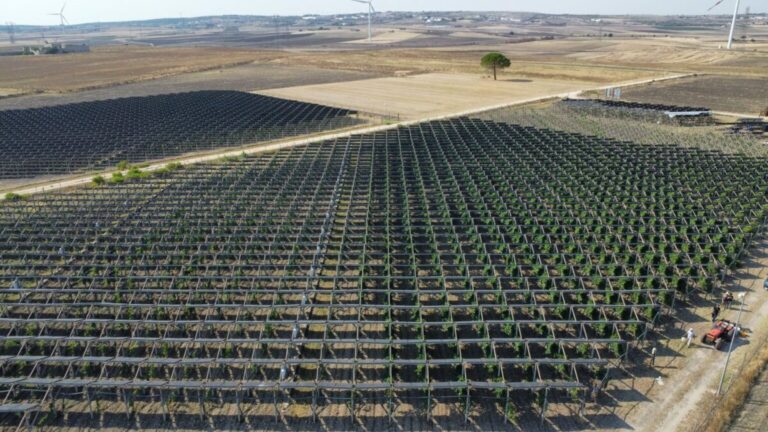Italian winemaker Svolta Srl has deployed an agrivoltaic facility at its vineyard in Apulia, Italy. The PV array enabled the cultivation of vines that are not normally viable at this latitude.
Wine producer Svolta Srl has installed an agrivoltaic system in its vineyard Vigna Agrivoltaica di Comunità in Laterza, in the Italian province of Taranto, in the sunny southern region of Apulia.
The south-facing 970 kW system features approximately 7,770 panels with different output powers: 135 W, 125 W and 100 W. The technology is largely an unspecified thin-film dual-junction. The modules are deployed at a tilt angle of 28 degrees.
The structure is made of reinforced concrete viticulture components, inspired by the typical structure of the pergola vineyard. The company produces two vines: the local Primitivo offering and Goldtraminer, a typical vine of the Dolomites in northern Italy and not normally compatible with the latitudes of this region.
The company said the agrivoltaic system delayed harvest compared to other farms in the area. Engineering studies show that it reduces exposure to extreme weather, reduces environmental impact, reduces water consumption by up to 20% and increases land yield by 20% to 60%.
Emilio Roggero of the Italian Association for Sustainable Agriculture (AIAS) added that the system helped the winemaker reverse a trend where warmer summers had pushed the harvest from early October to late September.
“The system established a delayed harvest, reduced water stress and protected the grapes from other meteorological excesses,” he said pv magazine Italy. “We have multi-year measurements of the reduced water stress of wine plants under agrivoltaic shade, carried out by Professor Maurizio Boselli from the University of Verona, starting from the 2009-2013 study in Valpolicella. Even at the most critical times around noon, the leaves of the plants under panels are in almost normal conditions, even if the leaves outside the panels in full sun are exposed to intense water stress.”
Prof. Giuseppe Ferrara and Prof. Andrea Mazzeo from the University of Bari confirmed these findings with further measurements. Roggero said the 2022 harvest took place in early October, but in 2024 they harvested the grapes for both grape varieties three to four weeks later than nearby areas.
The agrivoltaic structure protects plants from excessive heat, radiation and wind, reducing wind speed by half compared to open fields. Plants under the panels show better vegetative growth than plants in full sun.
Roggero said Primitivo grapes under the panels achieved good sugar levels and retained acidity, unlike sun-exposed grapes, which had high sugar content and low acidity with a high pH.
“Partial shading slows down the progress of the sugar content and this year our desired value of 21 degrees was reached in the last days of August while at the same time the grapes were already at 25 degrees in full sun, well above our target. he explained. “We observed a reduction of about 10% in sugar content and an increase in acidity of about 25% of grapes under agrivoltaic shade. Together with the University of Bari, checks on the different acid levels are underway and the data is being processed.”
Grapes with the ideal sugar content and acidity allow the production of high quality wines without the need for corrective oenological interventions, preserving the authenticity of the wine.
“Agricultural red wines are distinguished by greater lightness and elegance, and white wines by their freshness and excellent acidity. In the coming years we will also be able to offer sparkling wines according to the classical method, for which agrivoltaic white grapes are particularly suitable,” says Roggero. “Because of these characteristics, enhanced by refined oenological protocols, the agrivoltaic wines are presented as wines of high quality and because of the cultivation methods with very high sustainability, rare and in a sense exclusive. The price of agrivoltaic wine is therefore placed on par with the best productions in the sector in a range of wine shop wines.”
The Goldtraminer vine is characteristic of the Trentino region and the Verona area of northern Italy.
“This year we received a new Traminer with the right balance between sugar and alcohol content – 14% vol and acidity pH 3.45. The experiment yields positively surprising results,” Roggero said. “The same Primitivo di Gioia del Colle, grown in agriculture, shows elegance and good acidity reminiscent of fine red wines from the north.”
This content is copyrighted and may not be reused. If you would like to collaborate with us and reuse some of our content, please contact: editors@pv-magazine.com.


